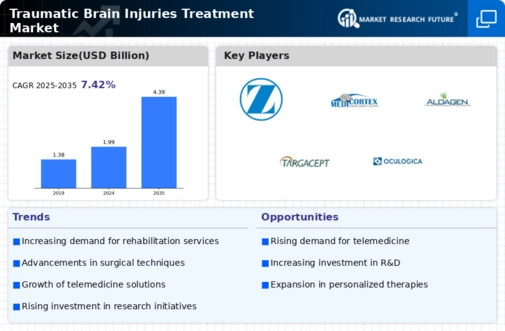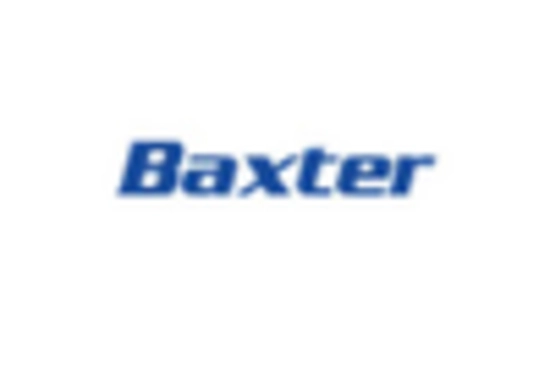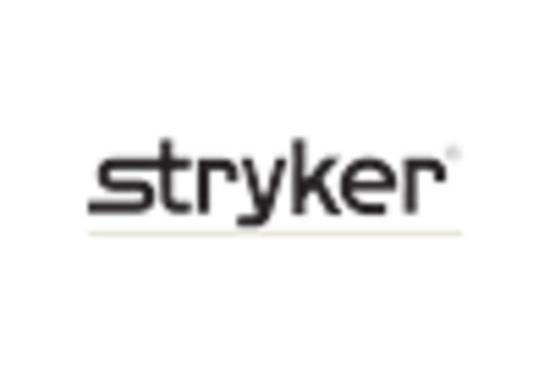Immediate Emergency Care
Medications
Diuretics
Anti-Seizure Drugs
Coma-Inducing Drugs
Anti-Anxiety Agents
Anti-Depressant
Anti-Psychotics
Analgesic
Anti-Convulsants
Anti-Coagulants
Surgery
Removing Clotted Blood
Repairing Skull Fracture
Bleeding in the Brain
Opening a Window in the Skull
Rehabilitation
Hospitals
Neurologist
Independent Pharmacies
Rehabilitative Center Treatment
Others
North America Traumatic Brain Injuries Treatment by TreatmentImmediate Emergency Care
Medications
Diuretics
Anti-Seizure Drugs
Coma-Inducing Drugs
Anti-Anxiety Agents
Anti-Depressant
Anti-Psychotics
Analgesic
Anti-Convulsants
Anti-Coagulants
Surgery
Removing Clotted Blood
Repairing Skull Fracture
Bleeding in the Brain
Opening a Window in the Skull
Rehabilitation
North America Traumatic Brain Injuries Treatment by End-UserHospitals
Neurologist
Independent Pharmacies
Rehabilitative Center Treatment
Others
US Traumatic Brain Injuries Treatment by TreatmentImmediate Emergency Care
Medications
Diuretics
Anti-Seizure Drugs
Coma-Inducing Drugs
Anti-Anxiety Agents
Anti-Depressant
Anti-Psychotics
Analgesic
Anti-Convulsants
Anti-Coagulants
Surgery
Removing Clotted Blood
Repairing Skull Fracture
Bleeding in the Brain
Opening a Window in the Skull
Rehabilitation
US Traumatic Brain Injuries Treatment by End-UserHospitals
Neurologist
Independent Pharmacies
Rehabilitative Center Treatment
Others
CANADA Traumatic Brain Injuries Treatment by TreatmentImmediate Emergency Care
Medications
Diuretics
Anti-Seizure Drugs
Coma-Inducing Drugs
Anti-Anxiety Agents
Anti-Depressant
Anti-Psychotics
Analgesic
Anti-Convulsants
Anti-Coagulants
Surgery
Removing Clotted Blood
Repairing Skull Fracture
Bleeding in the Brain
Opening a Window in the Skull
Rehabilitation
CANADA Traumatic Brain Injuries Treatment by End-UserHospitals
Neurologist
Independent Pharmacies
Rehabilitative Center Treatment
Others
Europe Traumatic Brain Injuries Treatment by TreatmentImmediate Emergency Care
Medications
Diuretics
Anti-Seizure Drugs
Coma-Inducing Drugs
Anti-Anxiety Agents
Anti-Depressant
Anti-Psychotics
Analgesic
Anti-Convulsants
Anti-Coagulants
Surgery
Removing Clotted Blood
Repairing Skull Fracture
Bleeding in the Brain
Opening a Window in the Skull
Rehabilitation
Europe Traumatic Brain Injuries Treatment by End-UserHospitals
Neurologist
Independent Pharmacies
Rehabilitative Center Treatment
Others
Germany Outlook (USD Billion, 2018-2032)
Germany Traumatic Brain Injuries Treatment by TreatmentImmediate Emergency Care
Medications
Diuretics
Anti-Seizure Drugs
Coma-Inducing Drugs
Anti-Anxiety Agents
Anti-Depressant
Anti-Psychotics
Analgesic
Anti-Convulsants
Anti-Coagulants
Surgery
Removing Clotted Blood
Repairing Skull Fracture
Bleeding in the Brain
Opening a Window in the Skull
Rehabilitation
Germany Traumatic Brain Injuries Treatment by End-UserHospitals
Neurologist
Independent Pharmacies
Rehabilitative Center Treatment
Others
France Traumatic Brain Injuries Treatment by TreatmentImmediate Emergency Care
Medications
Diuretics
Anti-Seizure Drugs
Coma-Inducing Drugs
Anti-Anxiety Agents
Anti-Depressant
Anti-Psychotics
Analgesic
Anti-Convulsants
Anti-Coagulants
Surgery
Removing Clotted Blood
Repairing Skull Fracture
Bleeding in the Brain
Opening a Window in the Skull
Rehabilitation
France Traumatic Brain Injuries Treatment by End-UserHospitals
Neurologist
Independent Pharmacies
Rehabilitative Center Treatment
Others
UK Traumatic Brain Injuries Treatment by TreatmentImmediate Emergency Care
Medications
Diuretics
Anti-Seizure Drugs
Coma-Inducing Drugs
Anti-Anxiety Agents
Anti-Depressant
Anti-Psychotics
Analgesic
Anti-Convulsants
Anti-Coagulants
Surgery
Removing Clotted Blood
Repairing Skull Fracture
Bleeding in the Brain
Opening a Window in the Skull
Rehabilitation
UK Traumatic Brain Injuries Treatment by End-UserHospitals
Neurologist
Independent Pharmacies
Rehabilitative Center Treatment
Others
ITALY Traumatic Brain Injuries Treatment by TreatmentImmediate Emergency Care
Medications
Diuretics
Anti-Seizure Drugs
Coma-Inducing Drugs
Anti-Anxiety Agents
Anti-Depressant
Anti-Psychotics
Analgesic
Anti-Convulsants
Anti-Coagulants
Surgery
Removing Clotted Blood
Repairing Skull Fracture
Bleeding in the Brain
Opening a Window in the Skull
Rehabilitation
ITALY Traumatic Brain Injuries Treatment by End-UserHospitals
Neurologist
Independent Pharmacies
Rehabilitative Center Treatment
Others
Spain Traumatic Brain Injuries Treatment by TreatmentImmediate Emergency Care
Medications
Diuretics
Anti-Seizure Drugs
Coma-Inducing Drugs
Anti-Anxiety Agents
Anti-Depressant
Anti-Psychotics
Analgesic
Anti-Convulsants
Anti-Coagulants
Surgery
Removing Clotted Blood
Repairing Skull Fracture
Bleeding in the Brain
Opening a Window in the Skull
Rehabilitation
Spain Traumatic Brain Injuries Treatment by End-UserHospitals
Neurologist
Independent Pharmacies
Rehabilitative Center Treatment
Others
Rest Of Europe Traumatic Brain Injuries Treatment by TreatmentImmediate Emergency Care
Medications
Diuretics
Anti-Seizure Drugs
Coma-Inducing Drugs
Anti-Anxiety Agents
Anti-Depressant
Anti-Psychotics
Analgesic
Anti-Convulsants
Anti-Coagulants
Surgery
Removing Clotted Blood
Repairing Skull Fracture
Bleeding in the Brain
Opening a Window in the Skull
Rehabilitation
REST OF EUROPE Traumatic Brain Injuries Treatment by End-UserHospitals
Neurologist
Independent Pharmacies
Rehabilitative Center Treatment
Others
Asia-Pacific Traumatic Brain Injuries Treatment by TreatmentImmediate Emergency Care
Medications
Diuretics
Anti-Seizure Drugs
Coma-Inducing Drugs
Anti-Anxiety Agents
Anti-Depressant
Anti-Psychotics
Analgesic
Anti-Convulsants
Anti-Coagulants
Surgery
Removing Clotted Blood
Repairing Skull Fracture
Bleeding in the Brain
Opening a Window in the Skull
Rehabilitation
Asia-Pacific Traumatic Brain Injuries Treatment by End-UserHospitals
Neurologist
Independent Pharmacies
Rehabilitative Center Treatment
Others
China Traumatic Brain Injuries Treatment by TreatmentImmediate Emergency Care
Medications
Diuretics
Anti-Seizure Drugs
Coma-Inducing Drugs
Anti-Anxiety Agents
Anti-Depressant
Anti-Psychotics
Analgesic
Anti-Convulsants
Anti-Coagulants
Surgery
Removing Clotted Blood
Repairing Skull Fracture
Bleeding in the Brain
Opening a Window in the Skull
Rehabilitation
China Traumatic Brain Injuries Treatment by End-UserHospitals
Neurologist
Independent Pharmacies
Rehabilitative Center Treatment
Others
Japan Traumatic Brain Injuries Treatment by TreatmentImmediate Emergency Care
Medications
Diuretics
Anti-Seizure Drugs
Coma-Inducing Drugs
Anti-Anxiety Agents
Anti-Depressant
Anti-Psychotics
Analgesic
Anti-Convulsants
Anti-Coagulants
Surgery
Removing Clotted Blood
Repairing Skull Fracture
Bleeding in the Brain
Opening a Window in the Skull
Rehabilitation
Japan Traumatic Brain Injuries Treatment by End-UserHospitals
Neurologist
Independent Pharmacies
Rehabilitative Center Treatment
Others
India Traumatic Brain Injuries Treatment by TreatmentImmediate Emergency Care
Medications
Diuretics
Anti-Seizure Drugs
Coma-Inducing Drugs
Anti-Anxiety Agents
Anti-Depressant
Anti-Psychotics
Analgesic
Anti-Convulsants
Anti-Coagulants
Surgery
Removing Clotted Blood
Repairing Skull Fracture
Bleeding in the Brain
Opening a Window in the Skull
Rehabilitation
India Traumatic Brain Injuries Treatment by End-UserHospitals
Neurologist
Independent Pharmacies
Rehabilitative Center Treatment
Others
Australia Traumatic Brain Injuries Treatment by TreatmentImmediate Emergency Care
Medications
Diuretics
Anti-Seizure Drugs
Coma-Inducing Drugs
Anti-Anxiety Agents
Anti-Depressant
Anti-Psychotics
Analgesic
Anti-Convulsants
Anti-Coagulants
Surgery
Removing Clotted Blood
Repairing Skull Fracture
Bleeding in the Brain
Opening a Window in the Skull
Rehabilitation
Australia Traumatic Brain Injuries Treatment by End-UserHospitals
Neurologist
Independent Pharmacies
Rehabilitative Center Treatment
Others
Rest of Asia-Pacific Traumatic Brain Injuries Treatment by TreatmentImmediate Emergency Care
Medications
Diuretics
Anti-Seizure Drugs
Coma-Inducing Drugs
Anti-Anxiety Agents
Anti-Depressant
Anti-Psychotics
Analgesic
Anti-Convulsants
Anti-Coagulants
Surgery
Removing Clotted Blood
Repairing Skull Fracture
Bleeding in the Brain
Opening a Window in the Skull
Rehabilitation
Rest of Asia-Pacific Traumatic Brain Injuries Treatment by End-UserHospitals
Neurologist
Independent Pharmacies
Rehabilitative Center Treatment
Others
Rest of the World Traumatic Brain Injuries Treatment by TreatmentImmediate Emergency Care
Medications
Diuretics
Anti-Seizure Drugs
Coma-Inducing Drugs
Anti-Anxiety Agents
Anti-Depressant
Anti-Psychotics
Analgesic
Anti-Convulsants
Anti-Coagulants
Surgery
Removing Clotted Blood
Repairing Skull Fracture
Bleeding in the Brain
Opening a Window in the Skull
Rehabilitation
Rest of the World Traumatic Brain Injuries Treatment by End-UserHospitals
Neurologist
Independent Pharmacies
Rehabilitative Center Treatment
Others
Middle East Traumatic Brain Injuries Treatment by TreatmentImmediate Emergency Care
Medications
Diuretics
Anti-Seizure Drugs
Coma-Inducing Drugs
Anti-Anxiety Agents
Anti-Depressant
Anti-Psychotics
Analgesic
Anti-Convulsants
Anti-Coagulants
Surgery
Removing Clotted Blood
Repairing Skull Fracture
Bleeding in the Brain
Opening a Window in the Skull
Rehabilitation
Middle East Traumatic Brain Injuries Treatment by End-UserHospitals
Neurologist
Independent Pharmacies
Rehabilitative Center Treatment
Others
Africa Traumatic Brain Injuries Treatment by TreatmentImmediate Emergency Care
Medications
Diuretics
Anti-Seizure Drugs
Coma-Inducing Drugs
Anti-Anxiety Agents
Anti-Depressant
Anti-Psychotics
Analgesic
Anti-Convulsants
Anti-Coagulants
Surgery
Removing Clotted Blood
Repairing Skull Fracture
Bleeding in the Brain
Opening a Window in the Skull
Rehabilitation
Africa Traumatic Brain Injuries Treatment by End-UserHospitals
Neurologist
Independent Pharmacies
Rehabilitative Center Treatment
Others
Latin America Traumatic Brain Injuries Treatment by TreatmentImmediate Emergency Care
Medications
Diuretics
Anti-Seizure Drugs
Coma-Inducing Drugs
Anti-Anxiety Agents
Anti-Depressant
Anti-Psychotics
Analgesic
Anti-Convulsants
Anti-Coagulants
Surgery
Removing Clotted Blood
Repairing Skull Fracture
Bleeding in the Brain
Opening a Window in the Skull
Rehabilitation
Latin America Traumatic Brain Injuries Treatment by End-UserHospitals
Neurologist
Independent Pharmacies
Rehabilitative Center Treatment
Others









Leave a Comment